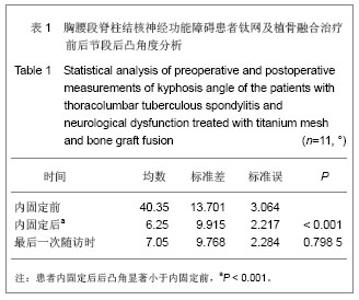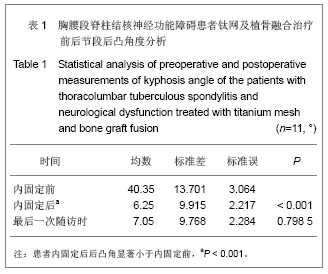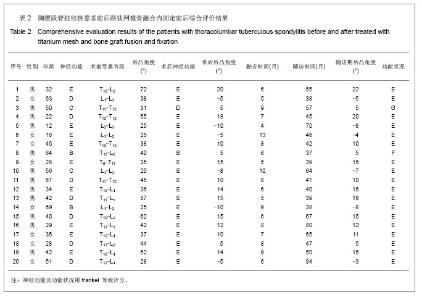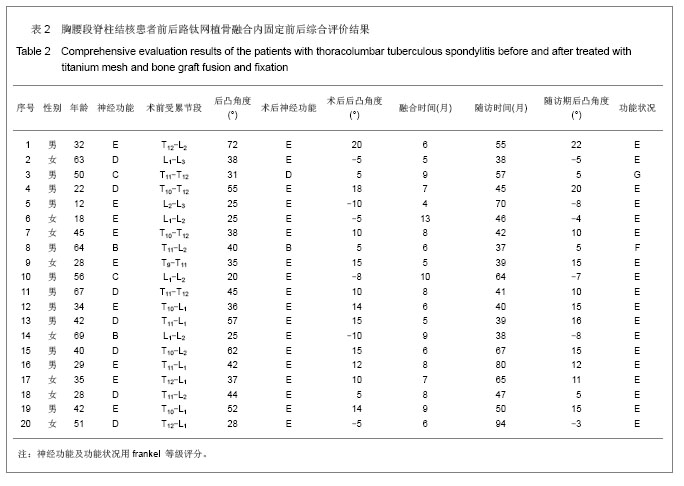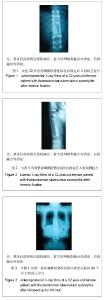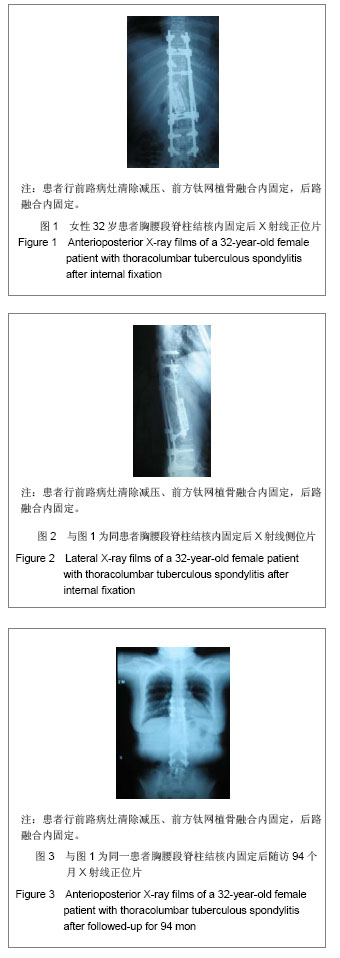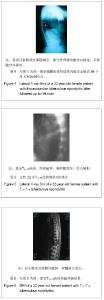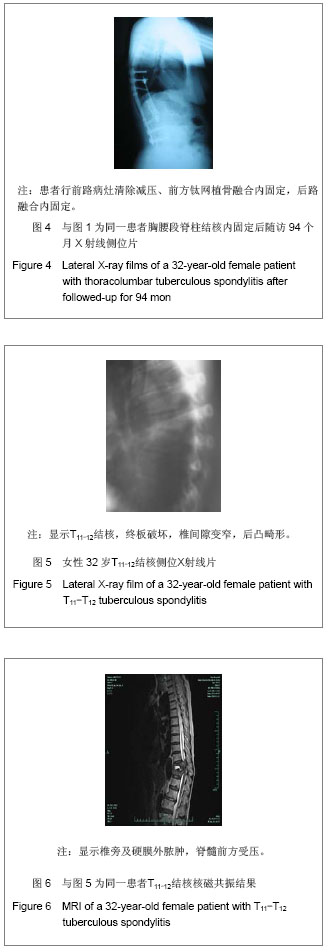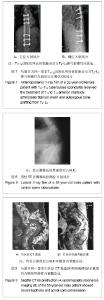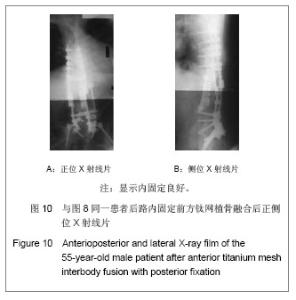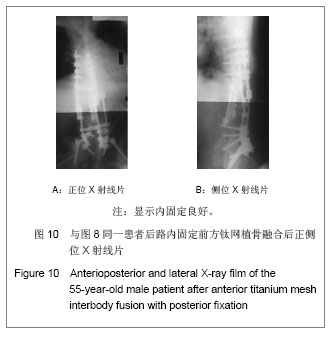| [1]Janssens JP, de Haller R. Spinal tuberculosis in a developed country. A review of 26 cases with special emphasis on abscesses and neurologic complications. Clin Orthop Relat Res.1990;257:67-75.[2]Hilibrand AS, Quartararo LG, Moulton MR. Spinal infections//Koval KJ (ed) Orthopaedic knowledge uptake 7. American Academy of Orthopaedic Surgeons.2003:661-672[3]Luk KD.Tuberculosis of the spine in the new millennium.Eur Spine J.1999; 8:338-345.[4]Moon MS. Spine update. Tuberculosis of the spine: controversies and new challenge. Spine.1997;22:1791-1797.[5]Hamzaog?lu A.Granulomatous infection of the spine.//Floman Y (ed) State of the art reviews,spinal infections. Hanley and Belfus, Philadelphia.1999:45-78.[6]Medical Research Council Working Party On Tuberculosis of the Spine. A 10-year assessments of controlled trials comparing debridement and anterior spinal fusion in the management of tuberculosis of the spine in patients on standard chemotherapyin Hong-Kong. J Bone Jt Surg (Br). 1982;64:393-398.[7]Moon MS, Moon YW, Moon JL,et al.Conservative treatment of tuberculosis of the lumbar and lumbosacral spine. Clin Orthop Relat Res. 2002;398:40-49.[8]Thirteenth Report Of The Medical Research Council Working Party On Tuberculosis Of The Spine.A 15-year assessment of controlled trials of the management of tuberculosis of the spine in Korea and Hong Kong. J Bone Jt Surg (Br). 1998;80: 456-462.[9]Wimmer C, Ogon M, Sterzinger W,et al.Conservative treatment of tuberculous spondylitis: a long-term follow-up study. J Spinal Disord.1997;10:417-419.[10]Moon MS, Woo YK, Lee KS et al.Posterior instrumentation and anterior interbody fusion for tuberculous kyphosis of dorsal and lumbar spine. Spine.1995;20:1910-1916.[11]Rajasekaran S, Soundarapandian S. Progression of kyphosis in tuberculosis of the spine treated by anterior arthrodesis. J Bone Jt Surg (Am). 1989;71:1314-1323.[12]Hodgson AR, Stock FE. Anterior spinal fusion: preliminary communication on radical treatment of Pott's disease and Pott’s paraplegia. Clin Orthop Relat Res. 1994;300:16-23.[13]Sundararaj GD, Behera S, Ravi V, et al. Role of posterior stabilisation in the management of tuberculosis of the dorsal and lumbar spine. J Bone Jt Surg (Br) 2003;85:100-106.[14]Benli IT, Acaroglu E, Akalin S,et al.Anterior radical debridement and anterior instrumentation in tuberculosis spondylitis. Eur Spine J.2003;12:224-234.[15]Chen WJ, Wu CC, Jung CH, et al. Combined anterior and posterior surgeries in the treatment of spinal tuberculous spondylitis. Clin Orthop Relat Res.2002;398:50-59.[16]Faraj AA.Anterior instrumentation for the treatment of spinal tuberculosis. J Bone Jt Surg (Am).2001;83:463-464.[17]Kim DJ, Yun YH, Moon SH,et al. Posterior instrumentation using compressive laminar hooks and anterior interbody arthrodesis for the treatment of tuberculosis of the lower lumbar spine. Spine.2004;29:275-279.[18]Klockner C, Valencia R. Sagittal alignment after anterior debridement and fusion with or without additional posterior instrumentation in the treatment of pyogenic and tuberculous spondylodiscitis. Spine.2003;15:1036-1042.[19]Ozdemir M, Us K, Ogun T. The role of anterior spinal instrumentation and allograft fibula for treatment of Pott disease. Spine.2003;28:474-479.[20]Wen-Jer C, Chi-Chuan W, Chi-Hsiung J. Combined anterior and posterior surgeries in the treatment of tuberculous spondylitis. Clin Orthop Relat Res.2002;398:50-59.[21]Yilmaz C, Selek HY, Gurkan I,et al. Anterior instrumentation for the treatment of spinal tuberculosis. J Bone Jt Surg (Am). 1999;81:1261-1267[22]Frankel HL, Hancock DO, Hyskop G. The value of postural reduction in the initial management of closed injuries of the spine with paraplegia and tetraplegia. Paraplegia.1969;7: 179-192.[23]Wu ZD,Wu ZH.Beijing: Beijing:People’s Mititary Medical Press. 2008.吴在德,吴肇汉.外科学[M].7版.北京:人民卫生出版社,2008.[24]Denis F, Armstrong GWD, Searls K,et al. Acute thoracolumbar burst fractures in the absence of neurologic deficit a comparison between operative and nonoperative treatment. Clin Orthop Relat Res.1984;189:125-141.[25]Fukuta S, Miyamoto K, Masuda T,et al. Two-stage (posterior and anterior) surgical treatment using posterior spinal instrumentation for pyogenic and tuberculotic spondylitis. Spine.2003;28:302-308.[26]Jin D, Qu D,Chen J,et al.One-stage anterior interbody autografting and instrumentation in primary surgical management of thoracolumbar spinal tuberculosis. Eur Spine J.2004;13:114-121.[27]Hee HT, Majd ME, Holt RT, et al. Better treatment of vertebral osteomyelitis using posterior stabilization and titanium mesh cages. J Spinal Disord Tech. 2002; 15:149-156.[28]Liljenqvist U, Lerner T, Bullmann V,et al. Titanium cages in the surgical treatment of severe vertebral osteomyelitis. Eur Spine J.2003;12:606-612.[29]Dvorak MF, Kwon BK, Fisher CG,et al. Effectiveness of titanium mesh cylindrical cages in anterior column reconstruction after thoracic and lumbar vertebral body resection. Spine.2003;28:902-908.[30]Eck KR, Bridwell KH, Ungacta FF,et al. Analysis of titanium mesh cages in adults with minimum two-year follow-up. Spine.2000;25:2407-2415.[31]Robertson PA, Rawlinson HJ, Hadlow AT. Radiologic stability of titanium mesh cages for anterior spinal reconstruction following thoracolumbar corpectomy. J Spinal Disord Tech. 2004;17:44-52.[32]Laheri VJ, Badhe NP, Dewnany GT. Single stage decompression, anterior interbody fusion and posterior instrumentation for tuberculous kyphosis of the dorso-lumbar spine. Spinal Cord. 2001;39:429-436.[33]Safran O, Rand N, Kaplan L,et al. Sequential or simultaneous, same-day anterior decompression and posterior stabilization in the management of vertebral osteomyelitis of the lumbar spine. Spine.1998;23:1885-1890. |
